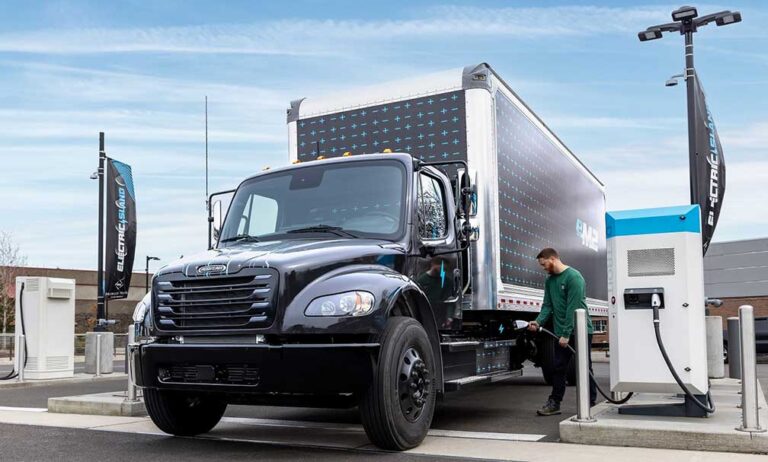The cost of fully electrifying the trucking industry is staggering.
There’s a lot more to consider than simply the cost of new vehicles — which is considerable in itself. The nation will need to build a network of charging stations that’s capable of powering thousands of heavy commercial vehicles each day.
Released in mid-March, the results of a recent study, commissioned by the Clean Freight Coalition (CFC) and conducted by Roland Berger, revealed that creating a sufficiently dense long-haul charging network would require an initial investment of at least $57 billion investment by fuel retailers.
To electrify all medium- and heavy-duty vehicles, fleets and charge point operators will need to invest $620 billion into chargers, site infrastructure, and utility service costs, the study notes.
These figures are swirling around the trucking industry, creating a firestorm of debate.
That’s because the U.S. Environmental Protection Agency (EPA) on Friday, March 29, released strict new emissions standards for heavy-duty trucks, buses, and other large vehicles. Officials say the new standards will help clean up some of the nation’s largest sources of planet-warming greenhouse gases.
According to the EPA, the new rules, which take effect for model years 2027 through 2032, will avoid up to 1 billion tons of greenhouse gas emissions over the next three decades and provide $13 billion in net benefits in the form of fewer hospital visits, lost workdays, and deaths. In particular, the EPA says, the new standards will benefit an estimated 72 million people in the U.S. who live near freight routes used by trucks and other heavy vehicles and bear a disproportionate burden of dangerous air pollution.
The new rules for heavy trucks and buses came just a week after the EPA announced new automobile emissions standards for passenger vehicles, which relax initial tailpipe limits proposed last year but are close to the same strict standards set out by the EPA for model year 2032.
The rule for trucks is complex, with a range of electric-vehicle or other non-traditional sales projected, depending on the type of vehicle and use. For instance, 30% of heavy-duty vocational trucks and 40% of short-haul day cab tractors must be zero-emission by 2032.
Not long after the release of EPA’s statement, trucking industry stakeholders — including fuel providers and retailers, as well as motor carriers and others — were firing out responses. Most lambasted the new standards as unreachable with current electric-vehicle (EV) technology and pointed out a lack of EV charging stations and power grid capacity limits.
Most groups say the EPA’s new emission standards for heavy-duty trucks have unachievable targets and will carry real consequences for the U.S. supply chain and movement of freight.
Like others in the trucking industry, Jim Ward, president of the Truckload Carriers Association (TCA), believes the new EPA rule will have a significantly negative impact on its members, as well as the industry as a whole.
“It’s important to recognize the progress that’s been made by our many TCA members who have tested equipment, trained both technicians and professional drivers, while incurring additional costs along the way to complying with EPA regulations instituted over the past couple of decades,” Ward said.
“The industry has effectively reduced NOx and particulate matters through the evolution and implementation of new technologies and remains committed to being a good steward of the environment,” he continued. “The journey ahead provides for many alternatives to be considered to lower carbon, such as blended biodiesel, renewable natural gas, diesel-electric — just to name a few — to help us bridge the gap to the future.
“We cannot just sit idly by and watch the implementation of a policy that will have a significant impact on our members’ business,” he concluded.
NATSO, an organization that represents America’s travel plazas and truck stops, and SIGMA: America’s Leading Fuel Marketers, said in a joint statement that while they appreciate that the Biden administration is working toward reducing carbon emissions, the new EPA rule is poised to have negative effects on trucking and its related industries.
“The administration’s final rule does not adequately consider the challenges that fuel retailers face in transitioning to heavy-duty truck electrification,” the joint statement noted. “The administration’s final rule also does not recognize the need to support lower carbon alternatives to diesel fuel that are currently commercially viable, such as biodiesel and renewable diesel.”
In addition, reports from the American Transportation Research Institute (ATRI) identify the many challenges facing commercial-vehicle electrification in the areas of U.S. electricity supply and demand, electric vehicle production, and truck-charging requirements.
“Off-highway refueling locations will need dozens of fast-chargers to service heavy-duty trucks,” the NATSO/SIGMA statement read. “The charging capacity required at a single large truck stop would be roughly equivalent to the electric load of an entire small town. Considering that utilities will need to invest $320 billion to upgrade the nation’s power grid, we remain unconvinced that the electricity providers will be able to increase generation and transmission activity to service that kind of load at scale within 10 years.”
The American Trucking Associations (ATA) “opposes this rule in its current form because the post-2030 targets remain entirely unachievable given the current state of zero-emission technology, the lack of charging infrastructure and restrictions on the power grid,” said Chris Spear, the association’s president and CEO.
While the EPA’s final rule includes lower zero-emission vehicle rates for model years 2027-2029, the ATA says forced zero-emission vehicle penetration rates in the later years will drive only battery-electric and hydrogen investment, limiting fleets’ choices with early-stage technology that is still unproven.
“The trucking industry is fully committed to the road to zero emissions, but the path to get there must be paved with common sense,” Spear said. “While we are disappointed with today’s rule, we will continue to work with EPA to address its shortcomings and advance emission-reduction targets and timelines that are both realistic and durable.”
Jim Mullen, executive director of the Clean Freight Coalition (CFC), says the organization opposes the new EPA ruling, noting that today’s zero-emission commercial vehicles “fail to meet the operational demands of many motor carrier applications, reduce the payload of trucks, and thereby require more trucks to haul the same amount of freight and lack sufficient charging and alternative fueling infrastructure to support adoption.”
Referring to the Roland Berger study, Mullen pointed out that currently a diesel Class 8 diesel truck costs roughly $180,000 compared to an electric truck’s price tag of $400,000. Those increased costs will ultimately be borne on the backs of consumers, he said.
“On top of the costs to the truck and bus industries, utilities and the government will need to invest $370 billion to upgrade their networks and the power grid to meet the demands of the commercial vehicle industry alone, putting the price tag for an electric supply chain at nearly $1 trillion before one battery-electric commercial vehicle is purchased,” Mullen said.
Instead of demanding the adoption of technology that brings “exorbitant costs and operational concerns,” Mullen believes policymakers should support lower-carbon alternatives to diesel, such as biodiesel and renewable diesel.
Mullen stresses that the CFC supports sound policies that promote the sustainable and affordable transition to zero-emission commercial vehicles — and will embrace any powertrain to reach these goals and protect the integrity of the nation’s supply chain — “the Phase 3 GHG rule fails to meet that standard.”
This article originally appeared in the May/June 2024 edition of Truckload Authority, the official publication of the Truckload Carriers Association.
Editor’s Note: On May 1, 2024, following the initial print publication of this article in the May/June edition of Truckload Authority, a Congressional Review Act resolution that would overturn the EPA’s Phase 3 Greenhouse Gas emissions standards for heavy-duty trucks was introduced on Capitol Hill. Click here to find out more.
Born in Pine Bluff, Arkansas, and raised in East Texas, John Worthen returned to his home state to attend college in 1998 and decided to make his life in The Natural State. Worthen is a 20-year veteran of the journalism industry and has covered just about every topic there is. He has a passion for writing and telling stories. He has worked as a beat reporter and bureau chief for a statewide newspaper and as managing editor of a regional newspaper in Arkansas. Additionally, Worthen has been a prolific freelance journalist for two decades, and has been published in several travel magazines and on travel websites.








